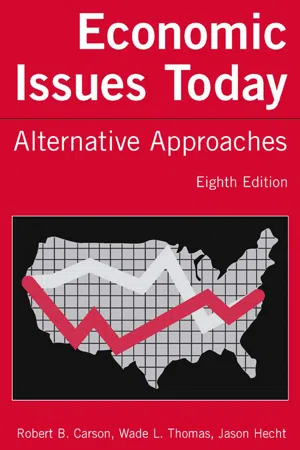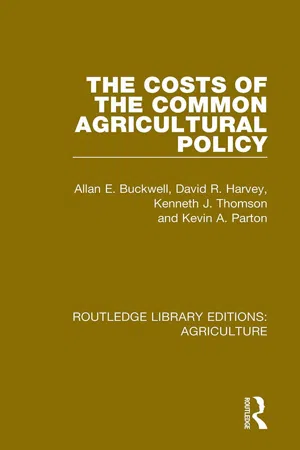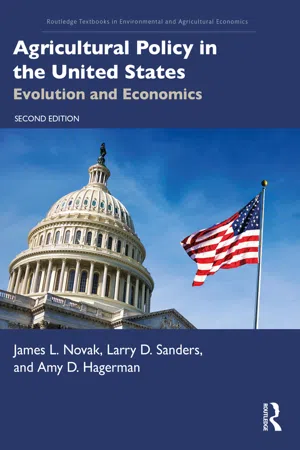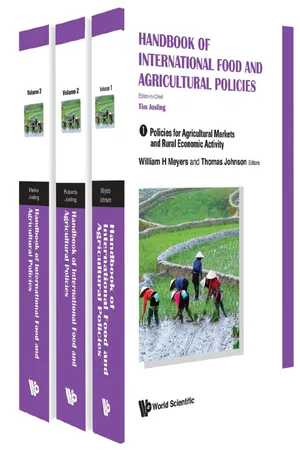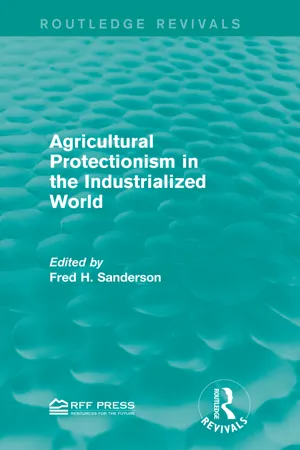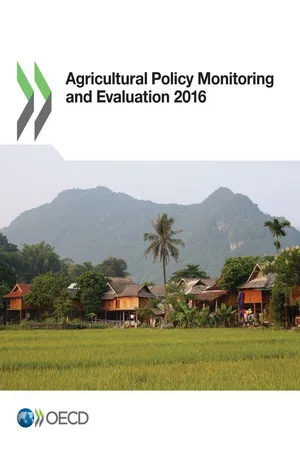Economics
Price Support
Price support refers to government intervention in the market to maintain the price of a particular commodity at a certain level. This is often achieved through measures such as subsidies, tariffs, or quotas. Price support is typically implemented to protect the income of producers and ensure a stable supply of the commodity.
Written by Perlego with AI-assistance
Related key terms
6 Key excerpts on "Price Support"
- eBook - ePub
Economic Issues Today
Alternative Approaches
- Robert B. Carson, Wade L. Thomas, Jason Hecht(Authors)
- 2015(Publication Date)
- Routledge(Publisher)
The Conservative focus on long-run trends in agricultural markets is misleading, and their argument for free agricultural markets is too simplistic. A long-run trend is nothing more than the average of a cycle of short-run highs and lows. If short-run fluctuations are extreme, especially the lows, the agricultural sector will be torn apart. Resources forced out of agriculture in bad periods will not return quickly when prices later rise. A farm is not an enterprise that can be worked for a few years and then briefly retired until a boom naturally reappears. The land blows away if it is not cultivated, and the equipment rusts and becomes obsolete. Neither the farmer nor the consumer, who would face violently fluctuating prices, should be subjected to the severity of short-run market readjustments. The laws of supply and demand, in fact, can be regulated to improve market outcomes.Price Support programs provide stability at a minimum cost. This, however, is not all that is required. Congress and the president came to grips with the failure of the 1996 Farm Act by enacting the Farm Security and Rural Investment Act in 2002, introducing a more sophisticated agricultural policy. For example, the Conservation Reserve Program has the U.S. Department of Agriculture (USDA) negotiating long-term contracts to pay farmers to refrain from cultivating land to “improve the soil, water, and wildlife resources.” Wetlands preservation and other environmental quality incentives have found their place in American agricultural policy because farmers are the country’s natural experts on stewardship of the land. When supplied with the proper financial incentives through markets and with the assistance of government to compensate for the uncertainties owing to markets and weather, the nation’s farmers earn a fair return for their efforts while securing a stable supply of food for domestic consumption as well as for export.THE RADICAL ARGUMENT
When conventional economics textbooks reach for an example in discussions of how supply and demand sets prices or how competition works, agricultural markets are usually cited. In the idealized models, at least, there are many small producers and consumers of homogeneous products who haggle and bargain until a fair and equitable price is established. For anyone vaguely familiar with the real-world conditions of American agriculture, the irony is heavy—nothing could be further from the truth. Perhaps because we start with such subtle deceptions when we talk about agricultural markets, we continue to deceive ourselves when we look for solutions to real farm problems. American agricultural affairs are dominated by a comparatively small number of giant producers, not by many small equal-sized farms, and prices are more the result of market power or government intervention than of the free market at work. For example, in 2000, Cargill, Archer Daniels Midland, and Zen-Noh accounted for more than 80 percent of corn exports. A similar pattern of four-firm dominance is found in beef packing, soybean crushing and exporting, flour milling, and terminal grain handling. Agriculture, as much as any sector of the economy, reveals the conflict between the professed ideal of a modified, production-for-profit system and the reality that a few benefit at the losses of many. The losers, of course, are small farmers and consumers in general. - eBook - ePub
- Allan E. Buckwell, David R. Harvey, Kenneth J. Thomson, Kevin A. Parton(Authors)
- 2019(Publication Date)
- Routledge(Publisher)
The next section of this chapter deals with the basic economics of Price Support for individual countries. This is extended to an economic community in the following three sections by including, respectively: community preference in agricultural trade; country-differentiated prices for agricultural commodities and the associated MCAs, and common financing of the community agricultural policy. The completed model is then summarised and the final section discusses important caveats and complications of the analysis.THE ECONOMIC EFFECTS OF Price Support: THE SINGLE COUNTRY CASE
Economists use the ideas of supply and demand schedules to describe the behaviour of producers and consumers in response to price changes and to analyse the determination of prices and the effects of policies which manipulate prices. Figures 3.3 shows the conventional upward sloping supply curve S and downward sloping demand curve D, for a commodity and (importing) country of interest. These indicate that, at the price level Pw, domestic production would be Sw and domestic consumption Dw. The difference (Dw – Sw) is made up by imports, assuming, initially, that foreign supplies are available at price Pw and that any volume can be purchased at this price. If it is decided to support domestic prices at a higher level, Pc, then production would increase to Sc, consumption falls to Dc and imports fall to (Dc – Sc). Such a higher price could be achieved by imposing an import levy of (Pc – Pw) on all imports so that foreign goods could not undercut domestically produced goods selling at the new protected price Pc.The extra production (Sc – Sw) over and above that called forth at the original price incurs additional costs which partly offset the extra revenue earned as a result of the higher price. Under certain conditions concerning the definition and specification of the supply curve, it is possible to assume that the supply curve shows, for each extra unit of output, the marginal costs of production. Thus area B + E, in Figures 3.1 - eBook - ePub
Agricultural Policy in the United States
Evolution and Economics
- James L. Novak, Larry D. Sanders, Amy D. Hagerman(Authors)
- 2022(Publication Date)
- Routledge(Publisher)
- Rural infrastructure enhancement
- Conservation/Environmental enhancement payments
Discussions of the history of these various policies and some discussion of their economic effects will be explored as we move through the text. Definitions and further explanations of these concepts follow. The following definitions are from multiple sources and reflect the authors’ interpretation of these definitions.Subsidies
Agricultural Subsidies Definition: Agricultural subsidies are an enhancement to income, input or output price, or production or marketing activity that’s provided by the government.Price subsidies result if farmers consider that the equilibrium (market clearing) price of a commodity is too low for them to earn a fair return. Through political pressure, the government might subsidize a commodities price. Figure 2.7 shows what happens when corn price is subsidized at the P1 level. At a subsidized price of P1, producers will supply Q2. Buyers will be unwilling to buy more than Q1 at the supported price. A surplus of Q2–Q1 occurs on the market as a result of the subsidized price.Figure 2.7 Government-Provided Price SubsidySurpluses, “Carry-Over”
Surplus commodities resulting from a price subsidy policy would have to be disposed of or would continue to have an impact on market price through the carry-over effect of the surplus. Lower prices could result through the following production season from a carry-over.Alternative government actions to dispose of surpluses could be to buy the surplus commodity and sell it on the world market (at a loss); ship it overseas as food aid; or simply throw it away. As will be discussed in the following chapters, each of these policies have been followed. Each of these actions had an impact on the market.Subsidized Production Costs
Government subsidies for agriculture have been implemented in various forms. One way is to lower a producer’s costs of production through subsidizing inputs. This results in a shift in individual producer marginal costs curves from MC1 to MC2, as shown in Figure 2.8 - eBook - ePub
Handbook of International Food and Agricultural Policies
(In 3 Volumes)Volume 1: Policies for Agricultural Markets and Rural Economic ActivityVolume 2: Policies for Food Safety and Quality, Improved Nutrition, and Food SecurityVolume 3: International Trade Rules for Food and Agricultural Products
- William H Meyers, Thomas Johnson, Donna H Roberts, Karl Meilke(Authors)
- 2017(Publication Date)
- WSPC(Publisher)
Non-recourse loans provided a tool for strengthening prices by allowing producers to sell commodities over a longer period and avoid an immediate post-harvest supply surge. The loans also allowed producers to forfeit their commodity rather than repay the loan if market prices fell below the loan rates, which served as price floors. Supplies and prices of perishable commodities, including milk, fruits, vegetables, and tree nuts, were addressed through marketing orders that controlled quantity, quality, and timing of marketing. Sugar and dairy producers were also supported through a combination of Price Support purchases and supply management (Benedict, 1953).While these systems of Price Support and supply control seemed to improve farm incomes and market conditions, natural production controls through drought and flood played a role in periodic price recoveries. Productivity improvements continued and threatened to undermine supply control efforts by creating ever-increasing surplus commodity stocks throughout the 1930s, and full recovery waited for the outbreak of World War II in Europe, with its attendant restoration of demand. Surplus government stocks provided a military reserve. Demand for food and fiber increased to supply the needs of US and allied military forces and civilian populations. To encourage greater production, the Government increased Price Supports and relaxed acreage allotments for an increasingly long list of commodities — well over 100 by the mid-1940s (Bowers et al ., 1984).Institutionalization of Price Supports and Protectionism, 1945–1973Fear of a post-war recession like that which had followed World War I led Congress to extend war-time price guarantees through 1948. Thus, even with continued high demand for farm products from expanding industrial employment and relief and rebuilding efforts in war-torn Europe and the Pacific, wartime price guarantees remained in place, eroding the association of Price Supports with emergency conditions. Moreover, many producers had invested the benefits of New Deal and wartime farm programs in expanding and modernizing their operations. The new machinery, electrical power, and chemical inputs they adopted further boosted their productivity and incomes, helping them acquire a standard of living on par with urban workers and business owners. Not confident that markets alone could sustain this new-found prosperity, increasingly organized agriculture sought to consolidate its gains, not to end emergency government intervention. - Fred H. Sanderson(Author)
- 2016(Publication Date)
- Routledge(Publisher)
Traill (1982) obtained similar results with an econometric model for the United Kingdom. The explanation is that Price Support policies make large-scale fanning more profitable and provide incentives for expanded production on large farms. At the same time, they may provide incentives for small farms to abandon farming. Rising product prices lead to progressive increases in farmland prices and in farm rental values, so that it may become more attractive for small farmers to quit agriculture. (This effect can be expected to be more significant in the long run than in the short run.)Employment in the nonagricultural sectors is also likely to decline because of agricultural Price Supports. Subsidization of one sector generally implies a taxation of others. One of the most important linkages is established by movements in real exchange rates. Support of one sector that stimulates additional exports or dampens imports leads to a revaluation of the currency, to the disadvantage of export and export-competing industries that are not supported or that receive less support than agriculture.Effects on the Structure of the Farm Sector
It is not clear how the Price Support policy in the EC has affected the economic structure of the farm sector. If the argument presented above is correct, structural change has been accelerated. The milk quota system may have contributed to this effect, since small dairy farmers got an additional incentive to sell their quotas because of high quota prices. On the other hand, it may well be that in some regions, where farmers have cultivated their own land and feel very attached to farming, the survival of small family farms has been prolonged. More empirical work is needed in this field.Effects on Agricultural Technology and Productivity
Price Support policy in the EC has influenced agricultural technology and productivity in two ways. First, it is known that technology development is dependent on price. Investment in research pays more if product prices are higher. Second, the adoption of new technologies is more profitable if prices are higher. High land prices owing to product Price Support make technical changes in land-saving technologies particularly profitable. Figure 2-6- OECD(Author)
- 2016(Publication Date)
- OECD(Publisher)
Market Price Support should therefore be reduced and eventually eliminated. This includes negative market Price Support still prevalent in a number of markets. Market Price Support is generally a non-transparent and untargeted measure inconsistent with a well-functioning multilateral trade system. If countries want to re-instrument and implement other, more appropriate measures, fiscal space must be available to do that.Other instruments, such as payments per unit of output or based on the use of variable inputs without any restrictions on their use, play a much smaller role overall but remain important in certain markets. Such instruments to some degree can be better targeted to specific policy objectives, but their potential to distort markets and trade is similar to that of market Price Support, and their cost-effectiveness in providing income support to needy farm households is rather low as a significant share of the outlays for these measures tends to leak away outside the farm sector. In addition, support for specific production inputs increases the risk of their over- or misuse, with potentially harmful consequences for farmers’ health and the environment.-
In most cases, payments per unit of output and input subsidies should therefore also be reduced. They represent an inefficient use of government budgets, and generally fail to appropriately target specific policy outcomes.
Support for on-farm investments and services can be important where market failures prevent an efficient allocation of resources. As such, it should focus on fostering innovation within the farm sector, helping to improve its environmental sustainability or to alleviate other market imperfections.Direct payments to farmers are increasingly used to support farm incomes. Farm income support, however, is not generally well targeted to those farm households in need and often privileges large farms if linked to historical production data. If well-targeted and tailored to the problem at hand, direct payments can present an effective tool for achieving specific policy objectives. Direct payments may also play an important transitory role in the process of reforming policies.
Index pages curate the most relevant extracts from our library of academic textbooks. They’ve been created using an in-house natural language model (NLM), each adding context and meaning to key research topics.
